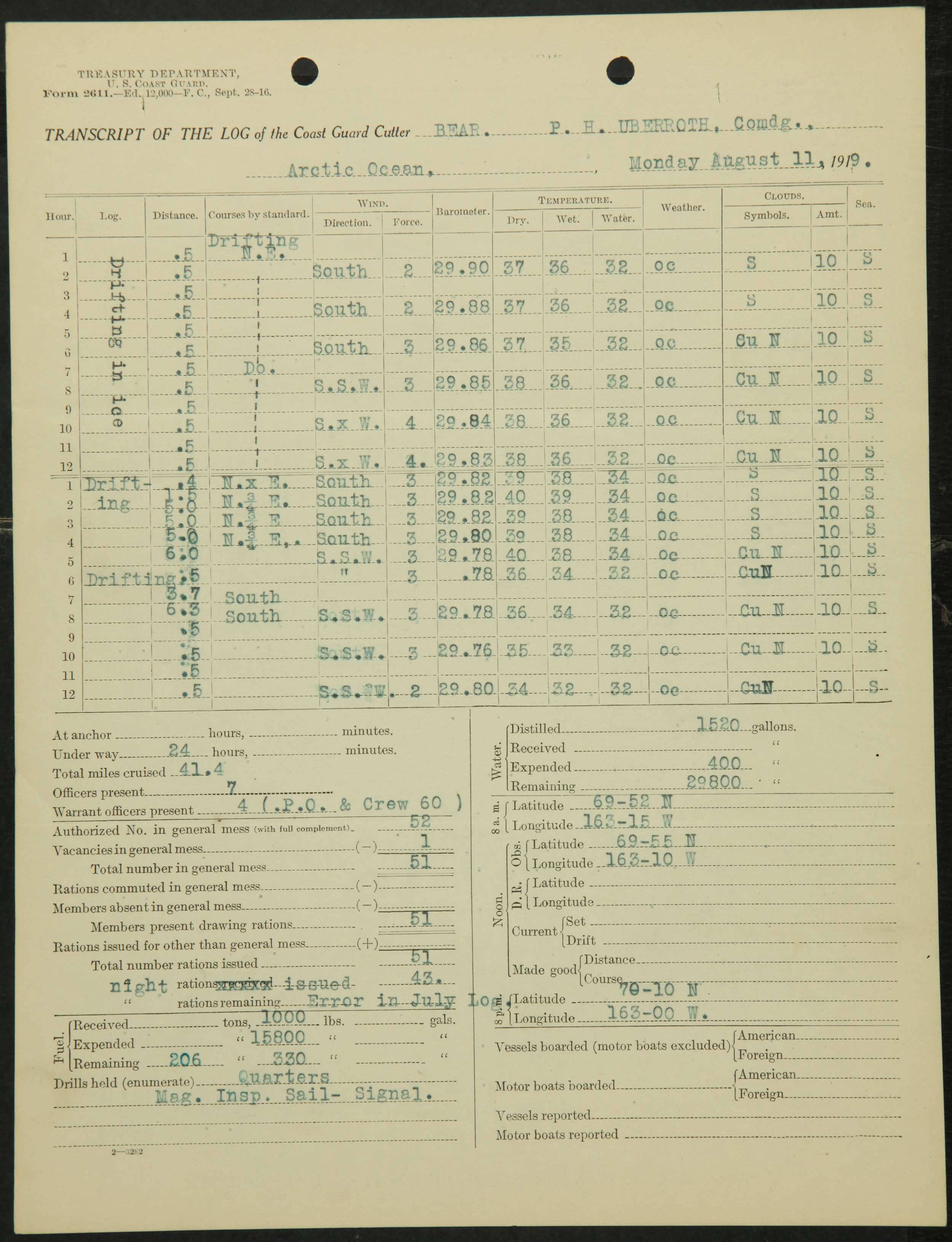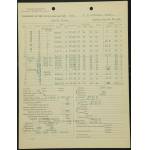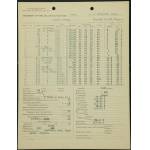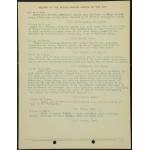Logbook of the USCG Cutter Bear
8/11/1919 - 8/12/1919
Add to Favorites:
Add all page(s) of this document to activity:

Add only page 1 to activity:
Add only page 2 to activity:
Add only page 3 to activity:
Add only page 4 to activity:
These pages from the logbook (also called a captain's log or deck log) of the USCG Cutter Bear record the weather, positioning, and events for August 11-12, 1919. The ship encountered heavy polar ice pack near Icy Cape, Alaska – thought at the time to be the southernmost limit encountered at this time of year. The logbook records the following observations:
August 11, 1919.
70 18N 163 01W
5:00 PM
On account of heavy ice pack ahead, stopped, on the south edge of the pack, awaiting shift of wind to the eastward. Ascertained that by reason of the southern limit of the ice pack being in the vicinity of Lat. 70 deg. N, and the continual drift of the pack to the southward since August 7, that the set of the current has been to the southward, entirely counter-acting the constant northerly current setting along the Alaska shore. It is thought that this is the extreme limit the pack has ever reached, that the southward set of the pack has been entirely due to continual northerly winds blowing for a long period of time.
August 12, 1919
70 19N 163 11W
5:00 PM
Stopped, dropped kedge to await an easterly shift of the wind, to clear sea of ice for further progress to the northward and eastward. The continual S.W. and South winds have banked ice up along the Alaskan shore, and made an impenetrable barrier north of Latitude 70 deg. 20' N, Longitude 163 deg. 00'W. On account of the leaky condition of the boiler it is not deemed expedient to stand to the northward and westward for a clear passage, because of the liability of strong east winds moving the pack off shore, thereby imprisoning the vessel and making extrication impossible.
See the entire logbook for the USCG Cutter Bear documenting January 1, 1918, to January 1, 1920, in the National Archives online catalog.
August 11, 1919.
70 18N 163 01W
5:00 PM
On account of heavy ice pack ahead, stopped, on the south edge of the pack, awaiting shift of wind to the eastward. Ascertained that by reason of the southern limit of the ice pack being in the vicinity of Lat. 70 deg. N, and the continual drift of the pack to the southward since August 7, that the set of the current has been to the southward, entirely counter-acting the constant northerly current setting along the Alaska shore. It is thought that this is the extreme limit the pack has ever reached, that the southward set of the pack has been entirely due to continual northerly winds blowing for a long period of time.
August 12, 1919
70 19N 163 11W
5:00 PM
Stopped, dropped kedge to await an easterly shift of the wind, to clear sea of ice for further progress to the northward and eastward. The continual S.W. and South winds have banked ice up along the Alaskan shore, and made an impenetrable barrier north of Latitude 70 deg. 20' N, Longitude 163 deg. 00'W. On account of the leaky condition of the boiler it is not deemed expedient to stand to the northward and westward for a clear passage, because of the liability of strong east winds moving the pack off shore, thereby imprisoning the vessel and making extrication impossible.
See the entire logbook for the USCG Cutter Bear documenting January 1, 1918, to January 1, 1920, in the National Archives online catalog.
This primary source comes from the Records of the U.S. Coast Guard.
National Archives Identifier: 23696536
Full Citation: Bear, January 1918 - January 1920; 8/11/1919 - 8/12/1919; Logs of Revenue Cutters and Coast Guard Vessels, 1819 - 1941; Records of the U.S. Coast Guard, Record Group 26; National Archives Building, Washington, DC. [Online Version, https://docsteach.org/documents/document/cutter-bear, April 25, 2024]Rights: Public Domain, Free of Known Copyright Restrictions. Learn more on our privacy and legal page.







